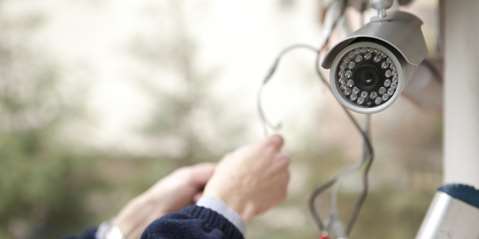Your Cart is Empty
Explore Schlage's Multi-Family Solution—Access Powered by ENGAGE™ Technology—Shop the Collection Today!
Categories
Industry
DIY Home Surveillance: How to Build Your Own Home Security System

If you’ve been thinking about installing a home security system in order to improve the safety of your residence, there are several different options and configurations to choose from. If you find the monthly costs of many home monitoring companies to be prohibitive, you can opt to build your own home security system on a surprisingly reasonable budget. Although the security needs of each household may vary, there are some basic components of home surveillance that are considered to be must-haves by home security experts. Below is a list of essential equipment to include as you build your DIY home security system.
1. Keyless Locks
Every solid home security system must begin with adequate door locks, and keyless locks are by far the best choice to make to secure the major entry points of your home. The Schlage FE575 Keypad Lock is an extremely versatile lock; its rugged, weatherproof construction makes it a perfect fit for both interior and exterior use. The FE575 features a 19 user code capacity, and is programmable right from the keypad; no complicated setup procedures required. Unlike many of its peers, the FE575 offers superior craftsmanship and aesthetic appeal to go along with its cutting-edge fit and function. It always locks automatically behind you, so you can be assured that whether you’re going out for a jog or grabbing a quick cup of coffee from the local cafe, your door will be safely locked, and you will quickly and easily be able to get back in.
2. Security Cameras
Security cameras are the heart of a DIY home surveillance system. The most common types of security cameras available for the DIY home security market are outdoor HD wireless cameras, which are typically mounted in areas that oversee key entry points. These types of cameras are fairly easy to install, since no in-house wiring is required. It is important to pick a camera that allows for panning and zooming functions, so you can zero in on certain areas of interest and control how much detail you can see. The BeHome247 Remote Security Monitoring Package provides you with high-quality 1280×960 display resolution cameras that are fitted with 4mm lenses, enabling you to have access to a 70-degree viewing angle. BeHome247 also provides indoor HD wireless cameras that offer a 300-degree pan and 120-degree tilt, so you can cover the widest amount of viewing area within your home. One of the most outstanding features of these cameras is their infrared night vision capability, which can detect images and movement up to 8 meters (approx. 26 feet) away. The BeHome247 Remote Security Monitoring Package also provides you with 1 GB of video storage, allowing you to store up to 60 hours of HD footage (120 hours for standard definition).
3. Motion Sensors
Motion sensors are some of the most beneficial tools for detecting home intruders. For example, you can place Linear Z-Wave door/window contact sensors on all of the key entry points of your home, and then arm them remotely using your smartphone or other WiFi-enabled device. If any security breach is detected, you can program the sensor to trigger a loud siren in order to scare off the intruder, or you can set up email/text alerts that will notify you that the sensor has been tripped. The Linear Z-Wave door/window contact sensor is fully compatible with the BeHome247 home automation system.
4. Smoke Detectors
Securing your home doesn’t just apply to deterring intruders; it also means protecting your home from fire damage. The Z-Wave wireless smoke detector is a highly effective device because it plays a dual role: It can alert you of potential fire hazards by emitting a loud beeping noise when you’re at home, but it can also alert you of excessive smoke when you’re away from home by sending you a text or email notification. This device connects seamlessly with the BeHome247 home automation package, so if you’ve installed cameras as a part of your system, you can then pull up your live video feed to see if there’s a fire or other related problem taking place.
A self-monitored home security system means that you’ll have lower start-up and installation costs, as well as no monthly fees. You’ll also be able to avoid those all-too-common false alarm fees that can occur when using some of the big brand home monitoring services. By building your own home security system, you’ll enjoy increased freedom and flexibility, and you’ll be able to customize your system to accommodate the specific needs of your family.
Browse by Category
© 2025 GoKeyless. All rights reserved. Privacy Policy. Terms of Use. Powered by Brandography.



 Over 5 Million Locks Sold
Over 5 Million Locks Sold Trusted Since 2003
Trusted Since 2003 Help
Help
